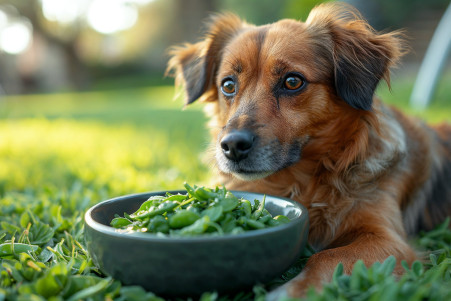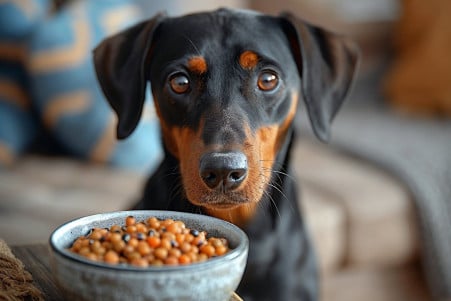Can Dogs Eat Green Peas? A Complete Guide
24 April 2024 • Updated 23 April 2024

Can you give your dog a handful of green peas to snack on, or is this legume something you should avoid? Green peas are safe for dogs and can even be a healthy treat when given in moderation. They are a good source of protein, vitamins, minerals, and fiber. That said, canned and salted peas are not safe for dogs, and you should always introduce new foods to your dog slowly to avoid any tummy troubles. In general, plain, fresh, or frozen green peas are a healthy treat for dogs.
We'll take a close look at the nutritional value of green peas for dogs and summarize findings from a number of studies conducted by veterinarians and animal nutritionists. This includes information on portion sizes, how to prepare green peas for dogs, the potential dangers of feeding your dog too many peas, and other vegetables that are just as nutritious and safe to feed your dog. By the end, you'll have all the information you need to confidently give your dog this fresh vegetable as a healthy treat in moderation.
Can dogs eat green peas?
Nutritional Benefits of Green Peas for Dogs
Green peas pack a powerful nutritional punch, making them an excellent addition to your dog's diet in moderation. These little legumes are a great source of plant-based protein, according to Purina. Protein is essential for building and repairing muscles and other tissues.
Peas are also loaded with essential vitamins and minerals. They are a good source of vitamin A for eye health, vitamin K for blood clotting, and iron for oxygen transport, as well as several other important vitamins and minerals. Plus, the fiber in peas can help with digestion and gut health, and it can help your dog feel full.
In addition, the antioxidants and anti-inflammatory properties of peas can help improve skin, heart, and eye health. And because they are low in calories, peas can be a good treat for dogs who need to lose weight or for senior dogs. They are nutrient-dense and low in calories, so they can help dogs feel full without adding extra pounds.
From vitamins, minerals, and fiber to plant-based protein, peas are a nutritional powerhouse for dogs. When part of a well-rounded diet, they can help contribute to a dog's overall health.
Portion Control and Preparation
Peas should be fed to dogs in moderation and as a treat rather than a staple. According to PetMD, treats, including peas, should not exceed 10% of a dog's daily caloric intake. Fresh or frozen peas are the best options because Daily Paws says canned peas are often high in sodium.
To help dogs digest peas better, Raw and Fresh recommends cooking or steaming them. However, it's important to note that when preparing peas for dogs, you should not add any seasonings, oils, or butter because these can be toxic.
If you stick to these portion control and preparation tips, you can give your dog this healthy veggie as an occasional treat.
Potential Risks and Precautions
Although green peas are safe for dogs, there are some potential risks and precautions to be aware of. The American Kennel Club explains that dogs with kidney issues should be careful with peas because of their purine content, which can exacerbate kidney issues.
In addition, The Dog People by Rover.com explains that pea pods can be a choking hazard, especially for small dogs, and recommends cutting them into smaller pieces before giving them to your dog. Eating too many peas can also cause digestive issues like gas, bloating, and diarrhea.
Canned peas are often high in sodium, which PetMD says can be toxic to dogs in large amounts. Dried peas may be harder for some dogs to digest, so it's best to introduce them in small amounts.
In general, while peas can be a healthy addition to your dog's diet, it's important to be mindful of portion sizes and potential risks, especially if your dog has a preexisting health condition.
Pea Protein and Processed Pea Products in Dog Food
Pea protein, flour, and starch are common plant-based protein sources in many commercial dog foods. According to Eli & Jojo's, pea protein is a starchy filler that is high in insoluble fiber. Although pea protein contains essential amino acids, Do Only Good Pet Food points out that it may be low in some important amino acids, including methionine and tryptophan.
Peas have also been implicated in the rise of dilated cardiomyopathy (DCM) in dogs. The American Kennel Club covered a study that suggested peas were one of the top ingredients in dog food that could be linked to the disease. However, more recent University of Guelph research found that feeding dogs diets containing up to 45% pulse ingredients had no adverse effects on heart health or body composition.
As with any ingredient, the key to feeding dogs a diet that contains pea-based dog food is to do so in moderation and as part of a balanced diet. While these plant-based proteins can be beneficial, they should not be the primary protein source in a dog's diet.
Substitutes and Fun Treat Ideas
Some other healthy and safe vegetable options for dogs are carrots, green beans, and sweet potatoes, says dogIDs. Meanwhile, apples, blueberries, and bananas are all examples of fruits that can be used to make dog treats. If you're looking for a crunchy snack, you can try dehydrated or baked pea chips or green bean chips.
Frozen peas or pea puree can be a great way to give dogs a refreshing treat when it's hot outside, notes BetterVet. Peas can also be used in dog treats or added to a dog's meals to help them get the nutrients they need, and in doing so, they can add some variety and health benefits to a dog's diet.
Although green peas are a good option, it's important to add other fruits and vegetables to a dog's diet to make sure they're getting all the nutrients they need. That said, dog owners can have fun coming up with different ways to give their dogs a well-rounded diet that includes a variety of healthy treats.
Conclusion: Feed Dogs Peas in Moderation
When fed in moderation, green peas can be a healthy and safe snack for dogs. They are a good source of vitamins, minerals, protein, and fiber that can help support a dog's overall health. However, it's important to take into account a dog's specific health concerns and dietary needs.
Peas should be a supplement to a balanced diet, not the main source of a dog's nutrition. PetMD notes that treats, including peas, should account for no more than 10% of a dog's daily caloric intake. Meanwhile, canned peas should be avoided because of their high sodium content.
As with any new food, it's a good idea to talk to a vet before introducing peas to a dog's diet, especially if the dog has any health issues. With the right precautions and portion control, green peas can be a healthy addition to a dog's diet.


